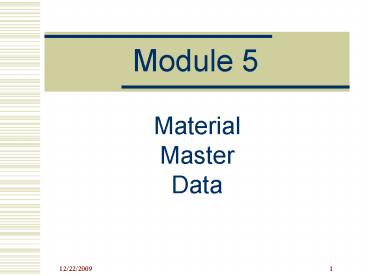Module 5
1 / 21
Title: Module 5
1
Module 5
- Material
- Master
- Data
2
Material Master Data
- An advantage of the SAP system is that it
maintains one set of data in real time. Material
data is used by many functional areas. In the
SAP system, there is one set of related data for
each material. With non-integrated systems, each
system may contain material data, and this data
is not always consistent. In the SAP system, the
data is consistently correct or incorrect. - Material Master data is organized by Views.
Depending on the type of material, only certain
views need to be used. As the system is
configured, additional views can be added as
necessary. - Many Material Master views are plant-specific
3
Material Master Views
- Basic Data 1
- Basic Data 2
- Classification
- Sales Sales Org Data 1
- Sales Sales Org Data 2
- Sales General/Plant Data
- Foreign Trade Export Data
- Sales Text
- MRP 1
- MRP 2
- MRP 3
- MRP 4
- Forecasting
- Work Scheduling
- General Plant Data/Storage 1
- General Plant Data/Storage 2
- Warehouse Management 1
- Warehouse Management 2
- Quality Management
- Accounting 1
- Accounting 2
- Costing 1
- Costing 2
Basic Data, Classification are not
plant-specific Other views are plant-specific
4
Material Master Views
NRG-A Bars Base unit Box Gross wt 6 lb.
Basic Data View
Non-plant specific
Plant specific
Plant 1000
Plant 2000
NRG-A Bars Lead Time 2 days Std. Price 16.80
NRG-A Bars Lead Time 3 days Std. Price 17.20
MRP Views
5
Navigating Material Master Views
Click on tabs to select Use direction arrows to
scroll Use icon to get list
6
Material Master Configuration
- Material Master Configuration allows a company to
customize the complicated Material Master to make
it easier for users to use correctly - Using Material Master Configuration, users can
- Control screen sequences and fields
- Control access to screens/views
- Preset organizational level and industry sector
7
Industry Sector
- Industry Sector determines what industry-specific
data appears in the material master record - Pre-defined industry sectors include
- Aerospace and Defense
- Chemical Industry
- Food and Related Products
- Mechanical Engineering
- Pharmaceuticals
- Plant Engineering/Construction
- Retail
- Retailing
- Service Provider
8
Material Types
- A Material Type is used to classify materials
- Defines material attributes like
- Valuation (value of material as market changes)
- Procurement (internal, external or both)
- Controls screen sequence and number assignment
- Can restrict access using authorization groups
- A number of material types are pre-defined
- Abbreviations are abbreviations of German terms
- Users can create their own material types
- Usually best to copy a pre-defined type, then
modify
9
Material Types - Quizzable
- ROH Raw material
- Externally purchased only, no sales view
- Oats, Wheat Germ, Honey, Cinnamon, etc.
- HALB Semifinished Product
- No purchase or sales view
- Dough for NRG-A and NRG-B bars
- FERT Finished Product
- Produced internally, has sales views, no
purchasing views - NRG-A and NRG-B bars
10
Material Types Non-quizzable
- HAWA Trading Goods
- HIBE Operating Supplies
- VERP Customer returnable packaging
- LEER Empty containers
- KMAT Configurable material
- ERSA Spare parts
- DIEN Services
- NLAG Non-stock, non-valuated material
- UNBW Non-valuated, stocked material
- FHMI Production resources/tools
- WETT Competitive products
- PROD Product group
- IBAU Maintenance assembly
11
Material Status and Field Selection
- In addition to Industry Sector and Material Type,
Material Masters can be customized using - Material Status Controls use of material
- Define whether certain functions are allowed for
a material (e.g. create BOM for material) and
whether warning messages are issued - Field Selection Suppress, Display, Optional or
Required - Like Field Status in G/L Accounts
12
Material Master Configuration
13
Material Group
- Material groups are another tool to allow users
to control the selection of materials - Limit analyses to certain material groups
- Control searches in a simpler fashion than
classification
14
Units of Measure
- A base unit of measure must be identified for
each material master - Basically a label
- All data entered in Material Master (weight,
cost, etc.) is related to the base unit of
measure - Many standard units of measure are already
defined in the SAP R/3 system - Alternate units of measure can be defined for
different uses with the appropriate conversion
factor - Base unit of measure should be smallest unit of
measure used anywhere in the system
15
Units of Measure
16
Pre-defined Units of Measure
17
Documentation in Material Master
- The SAP R/3 system documents all changes to the
material master
Click for documentation
18
Documentation in Material Master
19
Purchasing Info Record
- Provides continuously updated information about
the relationship of a specific material with a
specific vendor - Provides default information for purchase orders
Material
Vendor
Purchasing Info Record
20
Purchasing Info Record
- Contains
- Current price and delivery costs for purchasing
organization or plant - Number of last purchase order
- Purchase order price history
- Tolerance limits for over/under deliveries
- Planned delivery time for material
- Vendor evaluation data
21
Purchasing Info Record
- Purchasing info records can be created directly,
as we will do in this class, or can be created
automatically when a purchasing document (e.g.
purchase order) is created or changed. - The Purchasing Info Record can be updated
automatically from purchase order data if the
Info Update indicator is set in the purchase
order. - Conditions is the SAP term for pricing in
purchasing, which can include discounts, freight
costs, surcharges, etc.































